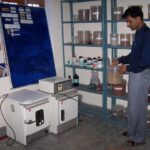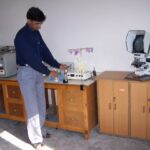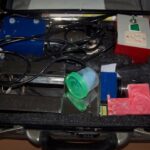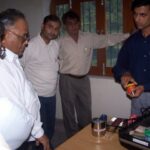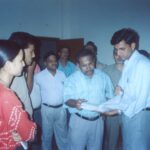RESEARCH & DEVELOPMENT AND APPLICATION OF NATURAL DYES
RESEARCH & DEVELOPMENT AND APPLICATION OF NATURAL AND ORGANIC DYES ON ANGORA WOOLEN PRODUCTS IN FIVE DISTRICTS OF UTTARAKHAND
INTRODUCTION AND BACKGROUND OF THE PROJECT
Handloom weaving, a cherished and time-honoured craft deeply ingrained in the cultural fabric of numerous regions across India, is renowned for its exquisite designs embellished with vibrant and harmonious colour combinations. Within this intricate art, the weft threads, which traverse horizontally through the warp threads, assume a pivotal role in shaping the essence of the design. They infuse life and character into the intricate patterns, creating a visual symphony that captivates the observer. Nevertheless, to elevate handloom products to a stature where they can command higher prices in the market, the utilization of dyed yarn is not merely advantageous, but indeed essential. Dyed yarn imparts an augmented depth of colour and richness to the fabric, rendering it more visually enticing and commercially appealing. The infusion of colour through dyed yarn resembles an artist wielding a broader palette, affording greater latitude for creative expression and conferring a distinctive character upon the final product. Acknowledging the pivotal role of dyed yarn in augmenting the market allure of handloom products, it becomes imperative to equip weavers and artisans with advanced dyeing techniques. This is where workshops assume a paramount role as invaluable educational platforms. Workshops, meticulously tailored to showcase enhanced dyeing practices, serve as arenas for knowledge exchange. They empower weavers and artisans with the requisite skills and insights to proficiently dye yarn, enabling them to craft handloom marvels that resonate with a discerning market. By cultivating a culture of perpetual learning and skill refinement, these workshops kindle an aspiration within weavers and artisans to instil greater value into their meticulously crafted masterpieces.
Furthermore, the promotion of vegetable and natural dyes in the production of yarn and woolen products transcends being a mere choice; it is an inherent responsibility. In an epoch where sustainability and eco-consciousness reign supreme, natural dyes emerge as champions. Derived from renewable botanical sources, these dyes offer a sustainable and environmentally considerate alternative to chemical counterparts. Moreover, natural dyes often yield hues that are subdued, earthy, and visually pleasing, imparting an unparalleled charm to handloom creations. Against this backdrop, the project unfurled as an emblem of transformation and progress. Its core mission centred around standardizing the utilization of natural colours and their meticulous application on woolen products. The project endeavoured to fortify the handloom weaving industry by advocating sustainable dyeing practices. In doing so, it aimed to ensure that the handloom products arising from this endeavour not only exuded vibrancy and allure, but also adhered to the most stringent quality benchmarks. In essence, the project transcended the realm of a mere undertaking; it metamorphosed into a catalytic force situated at the crossroads of tradition and innovation. It breathed renewed vitality into an age-old craft, infusing it with contemporary techniques and sustainability tenets. Through workshops and education, it empowered artisans to fashion handloom marvels that could not only enrich their lives, but also contribute to the broader legacy of Indian craftsmanship. In its advocacy for natural dyes, it celebrated the Earth’s bestowals, whilst setting a resounding precedent for conscientious production.
AIMS AND OBJECTIVES OF THE PROJECT
1. Implement a holistic strategy to promote sustainability and environmentally-conscious practices within the handloom weaving industry.
2. Systematically source and procure raw materials required for natural dyes, followed by standardizing extraction and dyeing methodologies, including rigorous chemical analyses of plant components to determine colour properties.
3. Provide comprehensive training programs to artisans, equipping them with in-depth knowledge of natural dye creation and its application to enhance the quality of woolen products.
4. Enhance the livelihoods of local artisans engaged in handloom weaving by increasing the market value of their crafted goods.
5. Foster strategic collaborations with science and technology-driven resource organizations, facilitating technical support and establishing crucial market linkages.
6. Prioritize research and development endeavours, involving systematic experimentation with a wide array of dye sources to elevate the overall quality of the final products.
7. Pave the way for the adoption of environmentally-friendly mordanting techniques, which are integral to the natural dyeing process.
COMPONENTS AND ACTIVITIES OF THE PROJECT
1. Promote sustainable and environmentally conscious practices within the handloom weaving industry through a multifaceted project structure.
2. Source and gather raw materials from dye-yielding plants located in mountainous regions, while conducting ecological assessments to ensure responsible collection practices.
3. Engage in extensive research and developmental efforts pertaining to the utilization of dye sources, encompassing the experimentation with various colour shades, dye testing methodologies, and the creation of dissemination mechanisms.
4. Promote the widespread adoption of natural dyes on a large scale, which includes conducting sample dyeing processes for both angora and woolen products.
5. Establish self-help groups with a vested interest in dyeing as an activity that adds value, while simultaneously disseminating pertinent technology at the grassroots level.
6. Reinforce the handloom weaving industry, elevate product quality standards, and enhance livelihoods by embracing and implementing sustainable practices.
TARGET AREA OF THE PROJECT
The project was intricately tailored to direct its focus towards beneficiaries involved in vegetable and natural dyeing endeavours within the handloom spinning and weaving industry. These beneficiaries were situated across five districts in Uttarakhand, namely Tehri Garhwal, Uttarkashi, Chamoli, Dehradun, and Pithoragarh.
TARGET GROUPS AND BENEFICIARIES OF THE PROJECT
The project’s core objective revolved around providing support to low-income groups and tribal artisan families actively engaged in vegetable cultivation and natural dyeing activities within the handloom spinning and weaving industry.
FUNDING PARTNER OF THE PROJECT
The funding for the project was provided by the Council for Advancement of People’s Action and Rural Technology (CAPART), Ministry of Rural Development, Government of India, New Delhi.
SANCTIONED BUDGET OF THE PROJECT
The project received sanction from CAPART in the year 2009, as per sanction order No. ARTS/UCH/17/3/2007 dated 23.12.2009. The total budget approved by CAPART for the project was Rs. 32,70,000.00 for a duration of two years. Out of this sanctioned amount, Rs. 27,90,000.00 was provided by CAPART, while HIFEED contributed Rs. 4,80,000.00 towards the project.
OUTCOMES AND ACHIEVEMENTS OF THE PROJECT
The successful execution of the Research & Development and Application of Natural Dyes Project, has yielded the following outcomes and accomplishments:
1. Diligent efforts were undertaken to identify and procure raw materials from dye-yielding plants in mountainous regions, accompanied by a comprehensive assessment of the ecological health of these plants and specific plant parts used within the area.
2. A set of standardized extraction and dyeing procedures was established, informed by meticulous chemical analyses of plant constituents to determine their inherent colour properties.
3. Artisans and craftsmen received meticulous training in the intricate craft of producing natural dyes and skilfully applying them to a range of woolen products.
4. Local artisans’ creations gained notable value, resulting in increased economic gains and improved income for these skilled individuals.
5. Strategic alliances were formed with science and technology-driven resource institutions, in collaboration with marketing agencies, serving as essential sources of technical support and fostering vital market connections to effectively sell products adorned with natural dyes.
6. Extensive research and development initiatives were executed, particularly in the domain of dyeing raw materials, accompanied by the meticulous development of user-friendly technology dissemination methods.
7. A diverse array of colour shades and various dye testing methodologies underwent rigorous experimentation, leading to the seamless integration of natural dyes on a substantial scale, including sample dyeing of angora and woolen products.
8. To cultivate sustainable growth, self-help groups expressing interest in adopting dyeing as a value-enhancing pursuit were established, and technology dissemination was systematically carried out at the grassroots level to ensure widespread access to this invaluable knowledge.


